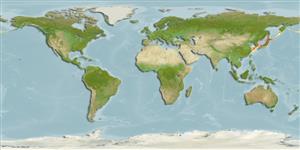Polyplacophora |
Chitonida |
Ischnochitonidae
Environment: milieu / climate zone / εύρος βάθους / distribution range
Οικολογία
; εύρος βάθους 0 - 80 m (Αναφ. 289). Subtropical
Northwest Pacific: Korea, Japan, and China.
Length at first maturity / Μέγεθος / Weight / Age
Γεννητική Ωρίμανση: Lm ? range ? - ? cm Max length : 2.5 cm TL αρσενικό/απροσδιόριστο; (Αναφ. 283)
Body elongate, oval shaped; moderately elevated. Valve slate-blue, dark olive-grey or dark grayish brown with blotches of creamy white. Central areas minutely pitted in a chevron-like or quincuncial pattern. Lateral areas slightly raised, clearly marked; sculptured with flat, radiating costae. Girdle narrow; colored like the valves, sometimes with alternating bands of lighter and darker tones; covered with imbricating scales.
Occurs in stony bottoms and in oyster beds (Ref. 289); undersurfaces of stones and rocks (Ref. 1867). Found from intertidal to 80 m (Ref. 75835).
Life cycle and mating behavior
Γεννητική Ωρίμανση | Αναπαραγωγή | Γεννοβολία | Eggs | Γονιμότητα | Larvae
Members of the class Polyplacophora are mostly gonochoric. Life cycle: Eggs hatch into lecitotrophic planktonic trocophore larvae (no veliger stage) which later metamorphose and settle on the bottom as young adults.
Burghardt, G. and L. Burghardt 2006 Selected Chitons of Asia, Japan and Pacific region. A Gallery of Worldwide Chitons: http://home.inreach.com/burghart/asia.html[accessed20/01/06] (Αναφ. 283)
IUCN Red List Status
(Αναφ. 130435: Version 2025-1)
CITES status (Αναφ. 108899)
Not Evaluated
Not Evaluated
Threat to humans
Harmless
Human uses
| FishSource |
Εργαλεία
Περισσότερες πληροφορίες
Τροφική ΟικολογίαFood items (preys)
Σύσταση δίαιτας
Κατανάλωση τροφής
Θηρευτές
Population dynamicsΑύξηση
Max. ages / sizes
Length-weight rel.
Length-length rel.
Length-frequencies
Mass conversion
Αφθονία
Life cycleΑναπαραγωγήΓεννητική ΩρίμανσηΓονιμότηταΓεννοβολίαEggsEgg developmentLarvae PhysiologyΚατανάλωση οξυγόνου
Human RelatedStamps, coins, misc.
Διαδικτυακές πηγές
Estimates based on models
Preferred temperature
(Ref.
115969): 10.2 - 23.9, mean 17.1 (based on 60 cells).
Fishing Vulnerability
Low vulnerability (10 of 100).
Price category
Unknown.
